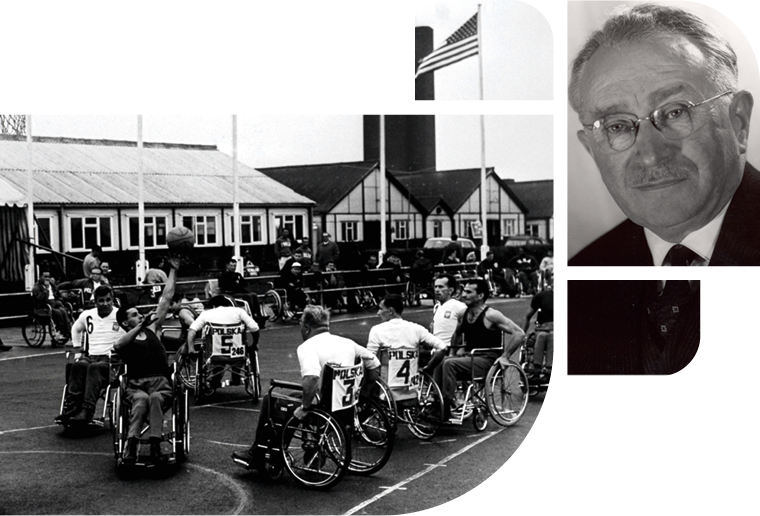History of the Paralympic Games
History
It all started with Sir Ludwig Guttmann. Born in 1899 in Upper Silesia, the Jewish neurologist was forced to flee National Socialist Germany in 1939 after having been dismissed as head physician in Breslau. On behalf of the British government, Guttmann founded a special clinic for spinal injuries.

Guttmann believed in the power of sport for those with a physical disability. At first, he concentrated on war veterans returning with serious injuries that made them wheelchair bound. Even though his focus was on medical rehabilitation, he also believed in the joy of competition to build physical strength and self-confidence.
„Stoke Mandeville Games“
precursor to the Paralympic Games

At the same time as the 1948 Olympic Games in London, the “Stoke Mandeville Games” were organised in Aylesbury in the south of England. On the grounds of the Stoke Mandeville Hospital, 16 wheelchair-bound sportsmen competed in an archery contest. From then on the competition was known – thanks to the location – as the “Stoke Mandeville Games” and became the precursor to the Paralympic Games.
The first milestone was reached in 1960 when the Games relocated to Rome and were – later – upgraded to the first “Paralympic Games” which attracted 400 athletes from 23 nations. Since then, the Games have been held every four years. Amputees and visually-impaired athletes competed for the first time in Toronto (Canada) in 1976 whilst athletes suffering from cerebral palsy followed in 1980. Then in 1998, athletes with an intellectual impairment competed for the first time in Nagano (Japan).
First Paralympic Winter Games Örnsköldsvik in 1976
The first Paralympic Winter Games were organised in 1976 when a total of 250 Alpine skiers from 14 nations fought for medals in Örnsköldsvik in Sweden. Another milestone was reached in 1994, when 469 athletes from 31 countries competed against each other in Lillehammer (Norway) to win one of a total of 399 medals in 133 different events – more than ever before or after.
Initially there were only Alpine or Nordic skiing events, Para ice hockey followed in 1994, wheelchair curling in 2006 and Para snowboard in 2014. On the occasion of the 1988 Games in Seoul, the term “Paralymics” was used for the first time. The word “Paralympic” derives from the Greek preposition “para” (alongside) and the word “Olympic”, even though other interpretations also exist.
However, the standard of the Games was continuously improved. The Paralympics have long since developed into an important international brand and thus moved out of the shadow of the “big brother“. As the third-biggest sports event apart from Olympic Games and the FIFA World Cup, people all over the world fall under the spell of Paralympic Games. The International Paralympic Committee (IPC), founded in 1989 and headquartered in Bonn since 1999, represents the interests of today more than 200 national para sports federations.
|
Year |
Country |
Nations |
Athletes |
|---|---|---|---|
|
1976 |
Örnsköldsvik (SWE) |
16 |
198 |
|
1980 |
Geilo (NOR) |
18 |
299 |
|
1984 |
Innsbruck (AUT) |
21 |
419 |
|
1988 |
Innsbruck (AUT) |
22 |
377 |
|
1992 |
Albertville-Tignes (FRA) |
24 |
365 |
|
1994 |
Lillehammer (NOR) |
31 |
469 |
|
1998 |
Nagano (JPN) |
31 |
562 |
|
2002 |
Salt Lake City (USA) |
36 |
415 |
|
2006 |
Turin/Torino (ITA) |
38 |
474 |
|
2010 |
Vancouver (CAN) |
44 |
502 |
|
2014 |
Sotschi / Sochi (RUS) |
45 |
541 |
|
2018 |
PyeongChang (KOR) |
49 |
563 |
|
2022 |
Peking / Beijing (CHN) |
50 * |
740 * |
